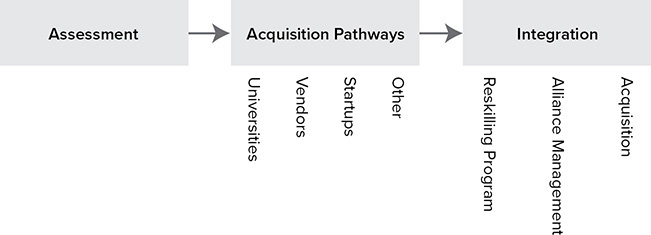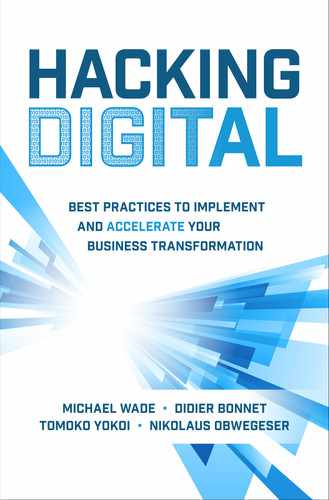CHAPTER
15
IMPLEMENTING OPEN INNOVATION EFFECTIVELY
Open innovation, or innovating with external partners, has been around for a long time.1 Despite its widespread popularity, the results of open innovation programs are a mixed bag, as companies often struggle to make it work.2 Challenges abound, from protecting intellectual property, to selecting the right external partners, to investing the required time and money to bring innovation back in-house. Yet research shows that open innovation practices have been accelerating over the past few years.3 Why? Digital technologies have made it significantly easier for organizations to tap external innovation sources and acquire the capabilities to compete in a rapidly changing world. However, balancing internal innovation with externally focused open innovation requires organizational and mindset shifts. Research shows that the organizations that are aware of these challenges, and that proactively formalize their open innovation practices, are more likely to reap its rewards.4
WHY IT MATTERS
Innovation projects today overwhelmingly rely on digital technologies, but many organizations lack the capabilities to develop them in-house.5 So to accelerate innovation, many organizations are opening up their innovation processes by sourcing external as well as internal ideas and pathways to market. Indeed, 78 percent of large companies in North America and Europe have adopted open innovation practices.6 These organizations are increasing their financial support and allocating more full-time resources toward open innovation. But it’s not plain sailing.
Open innovation requires clearly identifying which digital competencies will be strategic to an organization’s future, as well as requiring an understanding of where such competencies can be accessed externally. Moreover, it’s necessary to rebuild an innovation architecture to manage both internal and external resources and to ensure the transfer and scaling of successful ventures. Open innovation helps companies acquire capabilities in the short run, and building capabilities internally sustains competitive advantage in the long run, but how do digital leaders achieve the right balance?
BEST PRACTICES AND KEY INSIGHTS
According to research studies, organizations that purposefully design openness into their innovation efforts are best positioned to capture its advantages.7 Many organizations find it relatively easy to launch open innovation activities such as innovation labs, hackathons, or corporate accelerators,8 often by using intermediaries. But it’s much harder to leverage external knowledge and embed capabilities into an organization’s internal processes, beyond very limited structures or one-time events. So what does it take to really open up innovation?
Successful organizations design and implement open innovation by shifting their mindset toward external sources. They build or rebuild their innovation architectures from the ground up to incorporate both internal and external sources.
Creating an Open Innovation Mindset
Developing a mindset of open innovation can be a difficult shift for traditional organizations. It represents a marked departure from the “not invented here” syndrome that has plagued companies for decades. It’s more evolution than revolution, and it takes time.
Global industrial leader Siemens has a highly decentralized operating structure built around four main sectors: energy, healthcare, industry, and infrastructure. When the company launched open innovation programs in 2008, many people were skeptical and/or confused. As Tomas Lackner, head of Open Innovation S Scouting, noted: “Siemens as a company already had lots of connections to the external world, with more than 2,000 collaborations with roughly 1,000 universities! Obviously, the number of collaborations was not the point we wanted to address. Rather, we wanted to connect experts, both inside and outside of Siemens, and who didn’t know of each other before and who perhaps had already developed ideas and technologies that matched with our needs.”9
To encourage open collaboration and innovation in the Siemens culture, Lackner first initiated companywide “innovation jams” using online discussions that allowed people to rapidly share and discuss specific innovation topics. Lackner was also instrumental in developing TechnoWeb in 2009, an internal social media tool that helped network more than 35,000 experts within approximately 1,200 technology-oriented communities at Siemens.10 Having encouraged internal collaboration around innovation, Siemens was able to step outside its firewalls.
Lackner and his team also developed a series of idea-generation contests with external participants and universities to scope out joint research projects. In 2016, Siemens launched “next47,” an investment arm and startup accelerator to further open itself up to disruptive ideas. Through these successive external ventures, Siemens’s innovation community was able to evolve its open innovation mindset and embrace the benefits of external collaboration over the past decade.
A study of open innovation at NASA provides further insight. The study revealed that while an open innovation model led to scientific breakthroughs at record speeds, the most resistant scientists and engineers saw open-source methods as a challenge to their identities as innovative problem solvers. In contrast, those scientists who embraced open-source methods shifted their identities from “hero problem solvers” to “solution seekers.”11
Managers should encourage and reward solution-seeking behavior by recognizing those who find solutions in creative ways.
Identifying and Accessing Critical Capabilities
When companies have the digital capabilities to innovate, there is no need to go external. In fact, it can be counterproductive, exposing the company’s innovations to the outside world and making IP harder to protect. In addition, it’s fair to assume that some external partners will be working with the firm’s competitors. But with the ever-increasing demand for advanced digital skills such as IoT or machine learning, most companies will have no choice but to seek external input. (See Figure 15.1.)

Figure 15.1 Identifying and accessing digital capabilities
It’s critical to acquire a detailed understanding of which digital capabilities will help you to successfully transform and differentiate. Accessing data science expertise might be critical for the long-term health of a retailer, for instance, but it might not be for a real estate management company that needs to understand only sales and rental trends.
For the long run, you have to be clear on what capabilities will be strategic, enable differentiation and potential innovation—invest in building these capabilities in-house now. Outsourcing these strategic skills will limit achieving differentiation, and mostly provide parity with competitors that are leveraging similar outsourced partners.
—FARHAN SIDDIQI, CDO, AHOLD DELHAIZE12
The next critical step is choosing the best external routes to these capabilities, be they universities, startups, technology vendors, or others. With this mapping in hand, companies can develop a coherent portfolio for their open innovation program. Next comes the task of how to integrate these capabilities. This can be achieved through the reskilling of employees, alliance management, or outright acquisitions.
Monsanto, now part of Bayer, had a strategic need to develop data science capabilities. In addition to external partnering, the company launched a reskilling program that eventually grew its data science community to 500 members, with many biologists and process chemists turning into data scientists.13
Philips Consumer Lighting embarked on its open innovation journey in 2010, and has continually refined its integration of external technologies through a clear alliance management process. Philips’s alliance management comprises a small team of professionals who negotiate contracts, obtain agreements on key performance indicators, and develop tools to evaluate the partners’ perspectives on partnership evolution. The group is also responsible for managing regular meetings and project workshops to support effective knowledge transfer.14
Outright acquisition of companies to capture capabilities (aka “acquihire”) can also be effective when speed is of the essence. In 2019, restaurant chain McDonald’s acquired a number of startups to speed access to key capabilities in dynamic personalization, automation, and voice-based technologies.15
Embedding a New Innovation Architecture
Pursuing open innovation in an uncoordinated way rarely works. In fact, studies have shown that taking a hands-off approach generates poor results.16 The pursuit must be orchestrated through a clear and coherent innovation architecture, starting at the top. First, a clear logic is required for how and where open innovation ventures contribute to either growth strategy or business model evolution. Second, it’s good practice to have a senior executive oversee the innovation investments and efforts across the business to ensure focus and knowledge flows and to avoid duplication. Third, it’s important to be clear about the time horizon and the expected return for each open innovation project.
James Swanson, former CIO of Monsanto, quickly realized that he needed a clear innovation architecture to drive Monsanto’s transformation from a seed producer to a solutions provider from 2014 to 2018. At the time, Monsanto committed to investing in digital technologies, so it could gather and study all the data underlying decision making on farms. But thanks to a scarcity of in-house digital skills, Monsanto had to turn to external sources for certain capabilities in big data and analytics infrastructure, AI, and cybersecurity. To tap more external innovation sources, Monsanto built a data science center of excellence, using a centralized data platform driven by API and microservices, to run hundreds of AI models to improve supply chain and commercial activities.17
“You have to look at your assets and where you need a partner,” said Swanson. “For us, data and our scientific understanding of the data are tremendous assets. We’ve realized that internal capabilities are critical, as well as our networks and the modernization of our infrastructure.”
There is no one-size-fits-all approach to building an innovation architecture, but clear goals help determine the type of external sourcing required, as well as how best to connect it to the organization. For example, some open innovation will be long term and science/technology led, such as a research partnership with a university. Others will focus on discovery and incubation, such as startup accelerators and incubators. Others might be investment led, such as venture incubation or acquisitions.
Managing innovation architecture is a complex endeavor. It’s a balancing act between managing internal and external sources and figuring out how to best transfer and scale successes within your operational organization. It often requires dedicated innovation teams, some organizational surgery to ensure proper transfer (such as a testing sandbox for startups), and an understanding and proactive support from your internal functions, like HR and legal.
Hacker’s Toolbox
Build the team. Ensure that key individuals, scouts, and gatekeepers are in place to build open innovation capabilities. Scouts identify advances in science and technology, and gatekeepers support the transfer and dissemination of external knowledge and technologies into the organization. Not only do these roles help build an organization’s external network with different partners, but they also make open innovation visible within the entire organization.
Establish outcome metrics to measure the success of open innovation initiatives. The two leading outcome metrics often used by organizations are the amount invested into open innovation projects and the number of technological opportunities introduced to the organization.18 While the relevance of these metrics could be debated, the point is that successful organizations approach open innovation in an organized way through the application of metrics.
Ensure top management support. Be sure senior executives are overseeing the open innovation activities to ensure coherence with the firm’s growth strategy or business model ambitions. Several studies point to the role of top management support in open innovation success. Senior management is especially crucial for ensuring organizational commitment and support. While these executives may not be expected to have the skills of a practitioner, they should appreciate the skills and needs of the people they are asking to run open innovation.
Self-Reflection Questions
Who is accountable for innovation within your firm?
Do you have a good grasp of which digital capabilities you need to develop over time?
Can you develop those missing capabilities in-house fast enough, or do you need to access them through external sources?
If you need to access these capabilities externally, are you clear on the best sourcing strategy—e.g., partnerships, universities, startups, etc.?
Do you have the right internal innovation processes and leadership to bridge your internal and external innovation sources?
Are you clear about how open innovation ventures will contribute to business results and over what time horizon?
RELATED CHAPTERS
Building Hyperawareness into Your Organization (Chapter 12)
Managing Partnerships and Ecosystems (Chapter 13)
Investing in Startups (Chapter 14)
Building a Balanced Portfolio of Digital Initiatives (Chapter 20)
How Best to Develop Digital Skills Within Your Organization (Chapter 24)
